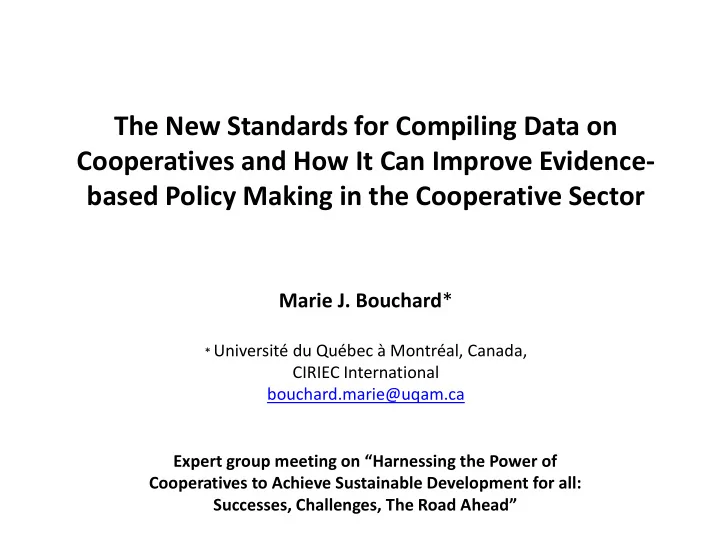

The New Standards for Compiling Data on Cooperatives and How It Can Improve Evidence- based Policy Making in the Cooperative Sector Marie J. Bouchard * * Université du Québec à Montréal, Canada, CIRIEC International bouchard.marie@uqam.ca Expert group meeting on “Harnessing the Power of Cooperatives to Achieve Sustainable Development for all: Successes, Challenges, The Road Ahead”
Introduction This project: • 2013 International Conference of Labour Statisticians (ICLS) Resolution for future work on coop statistics: – No agreed uniform statistical definition of co-operatives – Need of similar data for international comparability – Risk of misrepresentation of the co-operative world with few hard figures on the number of coops, workers, members, share of the GDP – Need of a better recognition of the economic and social impacts of coops by governments and people, improved policies for a model proved valuable (resilient to crises, sources of employment and social welfare…) • Conceptual framework , adopted by COPAC TWG (ILO 2017); Guidelines Concerning Statistics of Cooperatives , adopted at the 20 th ICLS (ILO 2018).
Structure of the presentation Introduction (backgound) 1. Stepping stones towards guidelines 2. Statistics on cooperatives: an overview of existing practices 3. Why do we need guidelines? 4. Objectives of the Guidelines concerning statistics of cooperatives Conclusion Bouchard, Le Guernic, Rousselière, Stirling,2017
The Committee for the Promotion and Advancement of Cooperatives (COPAC) is a multi- stakeholder partnership of global public and private institutions that champions and supports people- centred and self-sustaining cooperative enterprises as leaders in sustainable development. The ILO Department of Statistics and the Cooperatives Unit of the The UN Agency for the world of Work. Enterprises Department have been The ILO remains the only specialized working together on advancing the agency of the United Nations with an understanding of statistics on explicit mandate on cooperatives. cooperatives.
Through this joint initiative, and in collaboration with other partners, a number of outputs, including an analysis of statistics on cooperatives in more than 70 countries around the world. The ILO conducted case studies of Costa Rica, France, Italy, South Korea, Spain, Brazil, Canada, Colombia, the Philippines, Russia, and the United Kingdom.
2. Standard setting: How does it work? ICLS Resolutions & Guidelines The road to improving coop statistics through the ICLS 1. 2. 3. 4. 5. 6. Issue/area R&D by Consultation w/ Development ICLS ILO Governing Body Identification ILO Statistics national experts draft document -ICLS -Review national -Examines -Expert Group Meetings -Approves methodologies proposals resolutions & -Requests -Technical Working Groups guidelines -User/producer -Adopts -Reviews -City Groups consultations resolutions & guidelines -Issue report prepared ILO 6
Full report online on the ILO website at: http://www.ilo.org/global/topics/cooperatives/publications/WCMS_578683/lang- -en/index.htm
Major issues regarding cooperative statistical representation • Conceptual (boundary, scope, size) • Definition • Classification (types of cooperatives) • Types and numbers of members • Employment • On the measurements of the wealth produced by coops (value-added) • Data collection
Why guidelines? • No agreed uniform statistical definition of co-operatives • Why is it so important to get clear and reliable on cooperative measurements? - Lack of similar data for international comparability, misrepresentation of the co-operative world with few hard figures on the number of co-ops, workers, members, share of the GDP. - Need of a better recognition of the economic and social impacts of coops by governements and people, improved policies for a model proved valuable (resilient to crises, sources of employment and social welfare…)
The system of statistics should • facilitate the assessment of the size and scope of cooperatives’ activity in the economy; • enable more comprehensive and internationally comparable statistics on cooperatives; • provide information on various aspects of cooperatives’ contribution to the follow-up and implementation of the 2030 Agenda on Sustainable Development Goals (SDGs), especially job creation, poverty reduction, resources mobilization, investment generation and contribution to the economy; • inform the design and monitoring of specific support policies and assistance programmes for the cooperative sector as a whole and for its subsectors; and • facilitate analysis of the economic and social situation of particular groups of workers in this sector such as women, rural and urban population, youth and the elderly.
The Guidelines • clarifies the definition of cooperative for statistical purposes. • operationalizes cooperatives principles. • Four types of cooperatives compose a classification based on members’ main interest with regard to the cooperative. • This classification can be used to aggregate more granular types of cooperatives. • It also is compatible with classifying cooperatives also by their main economic activity according to national classification compatible with the International standard industrial classification (ISIC). • provides a framework to collect information on work by members and non-members of cooperatives, with reference to ICSE-93 and to the Resolution concerning statistics on work relationships adopted at the 20 th ICLS. • provide indications for data collection, tabulation and analysis.
Main references for this work EUM, H. 2018, Cooperative employment measurement: Categories, statistical variables and methods, Prepared for the the ILO Enterprises Department (Cooperatives Unit) and the ILO Statistics Department. EUM, H., C. CARINI & M. J. BOUCHARD 2018, Classification of Cooperatives. A proposed Typology , Prepared for the COPAC. ILO 2017, Conceptual Framework for the Purpose of measurement of Cooperatives and its Operationalization , Prepared by M. J. BOUCHARD, M. LE GUERNIC & D. ROUSSELIÈRE. ROUSSELIÈRE, D., M. J. BOUCHARD & M. LE GUERNIC 2018, Report on the Economic Contribution of Cooperatives, Prepared for the ILO Statistical Division.
Thank you ! Bouchard, Le Guernic, Rousselière, Stirling,2017
Recommend
More recommend